
current / archive / issues / faq / RSS feed / twitter /
Blog Archive: February 2018
The Master Plan Of Doctor DoomIf Stan Lee "only" wrote dialogue, as Jack Kirby would sometimes later claim, then he still more than earns his money in this issue, which is a cracking story full of character-based laughs. Kirby is operating at full throttle too, and it feels like their classic run is properly underway. Basically, this entire issue is ACE, and it kicks off in the best way possible, by having The Fantastic Four chase a dinosaur around the Baxter Building.
 The dinosaur has escaped from Doctor Doom's time machine which the FF have sensibly, finally, brought over from his abandoned castle. The dinosaur escaped because Ben and Johnny weren't watching the machine properly, which earns them a good telling off from Reed Richards, and this leads to several pages of delightful bickering, culminating in the other three members having a vote to see who should replace him as leader... and all voting for themselves.
The dinosaur has escaped from Doctor Doom's time machine which the FF have sensibly, finally, brought over from his abandoned castle. The dinosaur escaped because Ben and Johnny weren't watching the machine properly, which earns them a good telling off from Reed Richards, and this leads to several pages of delightful bickering, culminating in the other three members having a vote to see who should replace him as leader... and all voting for themselves.
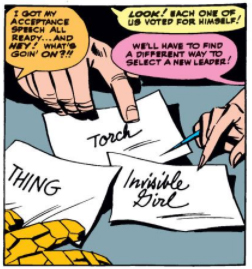 In the meantime we find out what Doctor Doom himself has been up to since he chucked himself out of a window at the end of Amazing Spider-Man #5. He's been putting together a new team to take down the Fantastic Four, selecting members by sending a robot (who possesses the power of thought, yet seems happy to consider itself disposable) down to the local court-house to find some suitably skilled crooks. Once he's got them assembled he uses his newly invented XZ-12 device to increase each crook's individual power (or "talent" really, as they're just Quite Good at things) twelve-fold.
In the meantime we find out what Doctor Doom himself has been up to since he chucked himself out of a window at the end of Amazing Spider-Man #5. He's been putting together a new team to take down the Fantastic Four, selecting members by sending a robot (who possesses the power of thought, yet seems happy to consider itself disposable) down to the local court-house to find some suitably skilled crooks. Once he's got them assembled he uses his newly invented XZ-12 device to increase each crook's individual power (or "talent" really, as they're just Quite Good at things) twelve-fold.
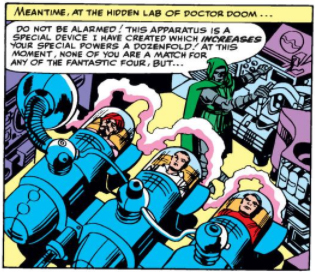 He's also got a cunning plan to take down the FF one by one, which seems sensible, and to start with it seems to be work. Doom's first assistant, Yogi Damor, tricks Johnny Storm into a flashy new car, and when the Torch tries to... um... burn him to death, he's disappointed to discover that the Yogi is impervious to heat and flames. This is probably a good thing, as otherwise the Torch would have become a murderer!
He's also got a cunning plan to take down the FF one by one, which seems sensible, and to start with it seems to be work. Doom's first assistant, Yogi Damor, tricks Johnny Storm into a flashy new car, and when the Torch tries to... um... burn him to death, he's disappointed to discover that the Yogi is impervious to heat and flames. This is probably a good thing, as otherwise the Torch would have become a murderer!
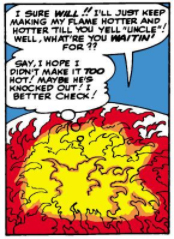 The Thing is lured down to Yancy Street by some abusive letters, claiming to be from the Yancy Street Gang but actually from the second member of Doom's team, Bill Brogin. Bill's "power" is that he's quite strong, and he gets into a fight with the Thing that's full of sarcasm.
The Thing is lured down to Yancy Street by some abusive letters, claiming to be from the Yancy Street Gang but actually from the second member of Doom's team, Bill Brogin. Bill's "power" is that he's quite strong, and he gets into a fight with the Thing that's full of sarcasm.
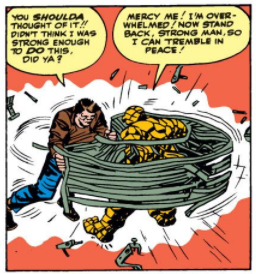 This snappy dialogue runs throughout the issue, coupled with super dynamic art which makes it whip along at high speed. I must admit that some of the comics so far have been a slog to get through, but this one was a delight!
This snappy dialogue runs throughout the issue, coupled with super dynamic art which makes it whip along at high speed. I must admit that some of the comics so far have been a slog to get through, but this one was a delight!
Brogin shoots a "cosmic ray gun" at The Thing, which turns him back into plain Ben Grimm - no match for someone with twelve times the strength of A Quite Strong man! If we're counting off Doctor Doom Character Tropes (and we surely are), we can definitely tick off "Amazingly useful bits of kit that never seem to get used again."
At this point we head back to the Baxter Building, where Reed Richards is trying to apologise to Sue by sneaking up and attacking her.
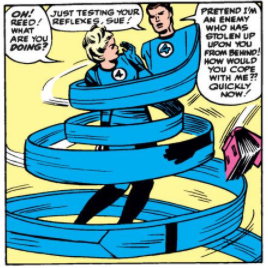 He claims to be "just testing her reflexes", but this seems to be very much the actions of what modern science would call "a total prat". When Sue is unimpressed he confirms this diagnosis with some heinous sexism, to which she reacts rather excellently with "Go polish a test tube".
He claims to be "just testing her reflexes", but this seems to be very much the actions of what modern science would call "a total prat". When Sue is unimpressed he confirms this diagnosis with some heinous sexism, to which she reacts rather excellently with "Go polish a test tube".
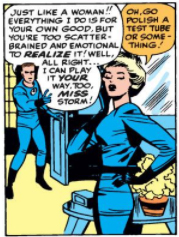 Unfortunately for all concerned this sexism infects the rest of the story, as Sue thinks "I know he's right, that's why I'm angry" as the third member of Doom's squad arrives. This is Handsome Harry whose power is Being Handsome... sorry, Having Good Hearing, so when Sue turns invisible he's able to spot where she is and blast her with some Ether Mist, then carry her away. Doom has been watching all these and responds in his usual way when things are going well - a good old laugh.
Unfortunately for all concerned this sexism infects the rest of the story, as Sue thinks "I know he's right, that's why I'm angry" as the third member of Doom's squad arrives. This is Handsome Harry whose power is Being Handsome... sorry, Having Good Hearing, so when Sue turns invisible he's able to spot where she is and blast her with some Ether Mist, then carry her away. Doom has been watching all these and responds in his usual way when things are going well - a good old laugh.
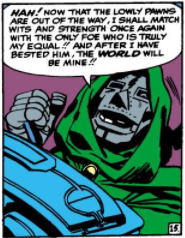 The final part of the plan kicks off with Ben Grimm apparently summoning Mr Fantastic with the FF Flare Gun. "Something must be wrong", he says when he sees it, "and it must be critical for him to use the flare signal!" Well, either that or he can't be bothered to use the phone. It is, of course, a trap, using yet another robot, which leads to Doom claiming victory. As usual he enjoys a good crow about it, and in doing so it's noticeable how his speech patterns have pretty much solidified into those of the Doctor Doom we will come to know later on. Any hint of slang or New Yorker-isms is gone, and instead he talks in a cool, calm manner without contractions. This refinement hasn't reached the artwork yet though, as Kirby depicts him sitting back in a distinctly relaxed fashion, feet up on the table.
The final part of the plan kicks off with Ben Grimm apparently summoning Mr Fantastic with the FF Flare Gun. "Something must be wrong", he says when he sees it, "and it must be critical for him to use the flare signal!" Well, either that or he can't be bothered to use the phone. It is, of course, a trap, using yet another robot, which leads to Doom claiming victory. As usual he enjoys a good crow about it, and in doing so it's noticeable how his speech patterns have pretty much solidified into those of the Doctor Doom we will come to know later on. Any hint of slang or New Yorker-isms is gone, and instead he talks in a cool, calm manner without contractions. This refinement hasn't reached the artwork yet though, as Kirby depicts him sitting back in a distinctly relaxed fashion, feet up on the table.
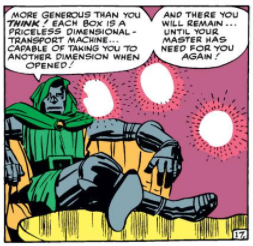 Doom is celebrating the fact that he's sent his lackeys into another dimension, ready to be called back when he needs them. Personally, if my boss tricked me into imprisonment I doubt I'd feel particular loyal to him afterwards, but as we've seen before, Doom tends to inspire loyalty wherever he goes.
Doom is celebrating the fact that he's sent his lackeys into another dimension, ready to be called back when he needs them. Personally, if my boss tricked me into imprisonment I doubt I'd feel particular loyal to him afterwards, but as we've seen before, Doom tends to inspire loyalty wherever he goes.
Once he's concluded his Human Resources issues Doom goes back to look at his prisoners, who are in the process of escaping. A big fight ensues, during which Doom uses all of his technical devices to force the four to a standstill, making, as he says, them all look daft.
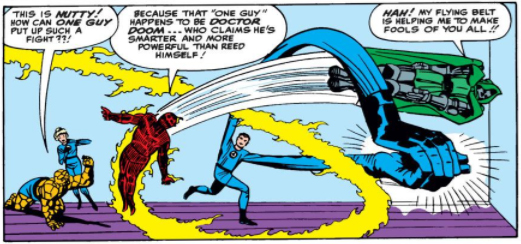 Doom leaves the room and begins the final part of his plan. The story's been a huge amount of fun so far, and it climaxes with a fantastic bit of nuttiness that, in a less enjoyable comic, might seem shoehorned in, but here fits in with the general air of excitement. Doom has specifically brought the Fantastic Four to this warehouse because it's in the path of a Solar Wave which will react with Ionic Particles and thus be transferred to space "in some strange way."
Doom leaves the room and begins the final part of his plan. The story's been a huge amount of fun so far, and it climaxes with a fantastic bit of nuttiness that, in a less enjoyable comic, might seem shoehorned in, but here fits in with the general air of excitement. Doom has specifically brought the Fantastic Four to this warehouse because it's in the path of a Solar Wave which will react with Ionic Particles and thus be transferred to space "in some strange way."
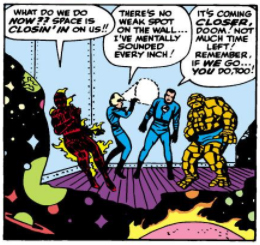 It's completely crazy, but also enormous fun, especially with Kirby's version of space encroaching, crammed with stars and planets. All looks lost, until Sue has an idea. She uses her new invisible force field (which she's developed since they last met Doom) to trap their nemesis on the other side of the wall. This forces him to climb back in through a hatch, at which point he trips over and, once again, falls into space.
It's completely crazy, but also enormous fun, especially with Kirby's version of space encroaching, crammed with stars and planets. All looks lost, until Sue has an idea. She uses her new invisible force field (which she's developed since they last met Doom) to trap their nemesis on the other side of the wall. This forces him to climb back in through a hatch, at which point he trips over and, once again, falls into space.
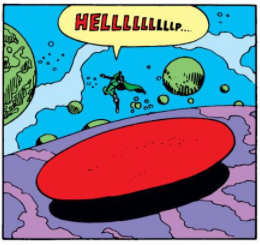 He really should be more careful. All that remains is for the FF to climb back through the hatch into safety, and then for the final caption to reassure readers that this is not the last they'll be seeing of Doom, and he'll be back once they've worked out how to do it!
He really should be more careful. All that remains is for the FF to climb back through the hatch into safety, and then for the final caption to reassure readers that this is not the last they'll be seeing of Doom, and he'll be back once they've worked out how to do it!
 Clearly they didn't want readers to worry, and though it would be a few months before they did figure out how to get him back, it would be worth the wait!
Clearly they didn't want readers to worry, and though it would be a few months before they did figure out how to get him back, it would be worth the wait!
posted 28/2/2018 by MJ Hibbett
(click here for permanent link)
(0) comments
At The Mercy Of Rama-Tut
This is yet another example of an issue in which Doctor Doom is mentioned as part of the story without actually appearing in it, although this time he does have a bigger presence than just being part of the recap.
He still IS part of the recap though, appearing in either The Fantastic Four Gallery Of Villains" or (I hope) "OUR Gallery Of Villains", depending on what we imagine the off-panel text to be.
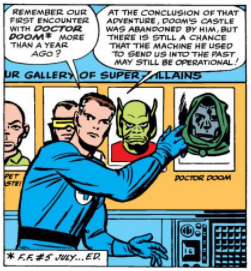 This sort of labelling would be heavily used three years later in the "Batman" TV series, but at this point seems to be commonly accepted as a sensible part of Superhero Admin. After all, if you don't actually SAY it's a gallery of villains, visitors might think it's a gallery of people you like.
This sort of labelling would be heavily used three years later in the "Batman" TV series, but at this point seems to be commonly accepted as a sensible part of Superhero Admin. After all, if you don't actually SAY it's a gallery of villains, visitors might think it's a gallery of people you like.
That's the only appearance of Doom in the story, but we do get a visit to his earliest headquarters, where I'm sure everyone will be relieved to discover that the crocodiles in his moat are alive and well, not boiled alive as previously feared.
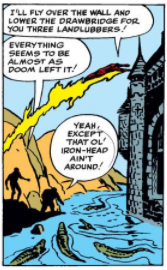 Alas we don't find out what happened to Doom's pet tiger, but we do see that lots of his equipment is still working, so maybe not everything was burned to the ground after all?
Alas we don't find out what happened to Doom's pet tiger, but we do see that lots of his equipment is still working, so maybe not everything was burned to the ground after all?
The FF are there to use his time machine to travel back to Egyptian times for a caper in which they meet a time traveller who, it's inferred, is a distant descendant of Doctor Doom
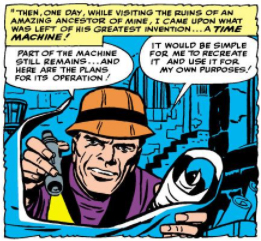 The exact relationship between Doom and Rama-Tut will be explained (also confused) in later issues, but for now he's rather delightfully portrayed as a 31st Century TV Addict who decided to use amazing futuristic technology to stave off boredom, something which I feel we can all identify with.
The exact relationship between Doom and Rama-Tut will be explained (also confused) in later issues, but for now he's rather delightfully portrayed as a 31st Century TV Addict who decided to use amazing futuristic technology to stave off boredom, something which I feel we can all identify with.
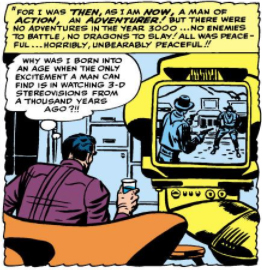 It's worth noting that once again Stan Lee is using television as an engine of plot. This is a theme that keeps cropping up during these early Marvel comics and it's perhaps evidence of an obsession with television that would eventually lead to Lee moving to California to try and persuade film and TV executives to create adaptations of his characters.
It's worth noting that once again Stan Lee is using television as an engine of plot. This is a theme that keeps cropping up during these early Marvel comics and it's perhaps evidence of an obsession with television that would eventually lead to Lee moving to California to try and persuade film and TV executives to create adaptations of his characters.
The FF manage to beat Rama-Tut and return to the present day, but still manage not to win, exactly. The whole point of travelling back in time had been to collect a radioactive herb which can cure Alicia's blindness, but when they get back to the present day they realise that the time machine has left it behind.
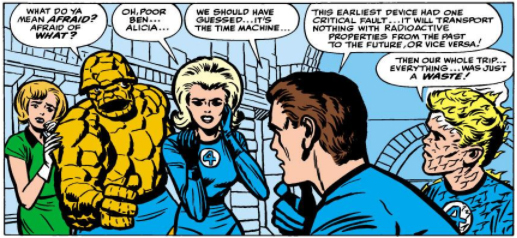 It's a surprisingly downbeat ending that demonstrates the way in which creators like Lee and Kirby were trying to do something different with their storytelling, apart from the usual stories of heroic characters constantly winning. Their stories featured not only sympathetic villains like Doctor Doom, but also fallible heroes who do not always emerge victorious.
It's a surprisingly downbeat ending that demonstrates the way in which creators like Lee and Kirby were trying to do something different with their storytelling, apart from the usual stories of heroic characters constantly winning. Their stories featured not only sympathetic villains like Doctor Doom, but also fallible heroes who do not always emerge victorious.
SPOILERS: if you don't enjoy fallible heroes, don't read the next blog. It's a Fallibility Festival!
posted 23/2/2018 by MJ Hibbett
(click here for permanent link)
(0) comments
It Had To Happen!
Just over a year since he first appeared, and still very much in the early stages of the Marvel Age, Doctor Doom makes his first "proper" hop into another series outside of The Fantastic Four with this appearance in Amazing Spider-Man #5. He's certainly been mentioned in several stories already, but this is his first actual appearance in another title, and an early example of the way that characters were free to move around between different series in the new Marvel Universe.
The series may have changed but Stan Lee is still the writer, so there are several recurring themes that recur (as recurring themes tend to do), including the use of television sets as plot engines. TV screens pop up throughout this issue, providing information and driving the story forward, such as in the very first panel where Peter Parker's schoolmates watch a J Jonah Jameson advertorial about how awful Spider-man is.
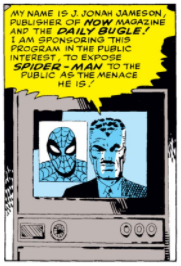 This blog is meant to be about the development of Doctor Doom as a character, but it's interesting to see the way that other characters are also in flux in these early days. For instance, the Peter Parker we meet here is not the guilt-ridden groovy teenager we come to know later on, but rather a distinctly angry, and somewhat unpleasant, young man who is full of inner rage towards pretty much everybody apart from his Aunt May.
This blog is meant to be about the development of Doctor Doom as a character, but it's interesting to see the way that other characters are also in flux in these early days. For instance, the Peter Parker we meet here is not the guilt-ridden groovy teenager we come to know later on, but rather a distinctly angry, and somewhat unpleasant, young man who is full of inner rage towards pretty much everybody apart from his Aunt May.
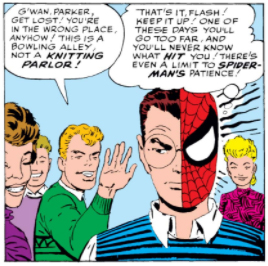 Doctor Doom is watching telly too, which gives him the idea to see if he can enlist Spider-man to help him beat The Fantastic Four - if he really is as bad as Jameson says, thinks Doom, he'd make a good partner. While mulling this over Doom handily recalls the last time we saw him, chucking himself out of an airship to escape the Fantastic Four.
Doctor Doom is watching telly too, which gives him the idea to see if he can enlist Spider-man to help him beat The Fantastic Four - if he really is as bad as Jameson says, thinks Doom, he'd make a good partner. While mulling this over Doom handily recalls the last time we saw him, chucking himself out of an airship to escape the Fantastic Four.
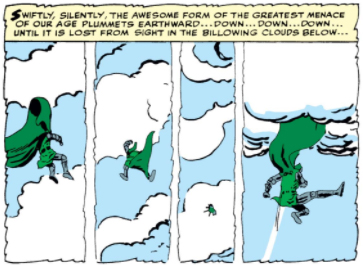 This sequence is almost exactly the same, in text and illustration, as his airship exit in Fantastic Four #17, except for an extra panel at the end showing him igniting his rocket belt. This attention to detail demonstrates a growing awareness of the importance of continuity, especially in the midst of the furious pace of production at Marvel. Having the two sections match so well shows that some care was taken to show that this was the same story as before, just being carried on in a different title.
This sequence is almost exactly the same, in text and illustration, as his airship exit in Fantastic Four #17, except for an extra panel at the end showing him igniting his rocket belt. This attention to detail demonstrates a growing awareness of the importance of continuity, especially in the midst of the furious pace of production at Marvel. Having the two sections match so well shows that some care was taken to show that this was the same story as before, just being carried on in a different title.
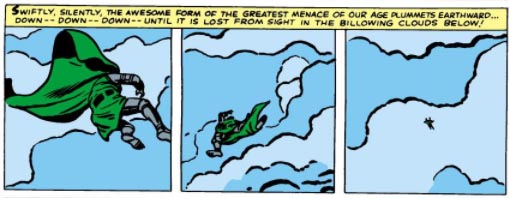 There's more evidence of the growing fictional universe on the next page when, after being called to Doom's lab by Spider Telepathy (something invented here but, as far as I know, never referred to again) Spider-man sees Doom through a window and says "I'd know that guy anywhere." According to the actual comics he's never met or even spoken about Doctor Doom before, so he must have found out about him at some other time, away from the comics page. This is evidence of a whole world of stories happening outside of the ones we get to read, a much larger ongoing storyworld which Matt Hills calls "the Hyperdiegesis" (and what I call "part of my PhD title").
There's more evidence of the growing fictional universe on the next page when, after being called to Doom's lab by Spider Telepathy (something invented here but, as far as I know, never referred to again) Spider-man sees Doom through a window and says "I'd know that guy anywhere." According to the actual comics he's never met or even spoken about Doctor Doom before, so he must have found out about him at some other time, away from the comics page. This is evidence of a whole world of stories happening outside of the ones we get to read, a much larger ongoing storyworld which Matt Hills calls "the Hyperdiegesis" (and what I call "part of my PhD title").
Doom asks Spider-man to team up with him, while secretly planning a double-cross.
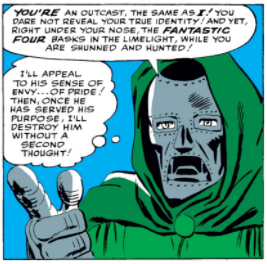 Spider-man considers the offer for a moment then declines, not because it's a bad idea but just because he doesn't think he needs a team-mate - another example of Peter Parker's much less heroic character at this stage. He webs Doom up, only to find out that he's been speaking to a robot... which is a little strange as, only a few panels ago, that robot was thinking about destroying him. This sort of logical error is evidence of the speed of creation of these comics, and highlights again how remarkable it was to see that flashback so meticulously done. Perhaps it's also evidence of Stan Lee not applying the same levels of rigour to his scripting as he does to the artists!
Spider-man considers the offer for a moment then declines, not because it's a bad idea but just because he doesn't think he needs a team-mate - another example of Peter Parker's much less heroic character at this stage. He webs Doom up, only to find out that he's been speaking to a robot... which is a little strange as, only a few panels ago, that robot was thinking about destroying him. This sort of logical error is evidence of the speed of creation of these comics, and highlights again how remarkable it was to see that flashback so meticulously done. Perhaps it's also evidence of Stan Lee not applying the same levels of rigour to his scripting as he does to the artists!
Spidey escapes and Doom blows up his lab to stop anybody finding out his secrets. Next day Peter pops over to the offices of the Daily Bugle for a brief interlude where we see the greed which drives J Jonah Jameson's editorial policy, and another flash of Peter's internal rage.
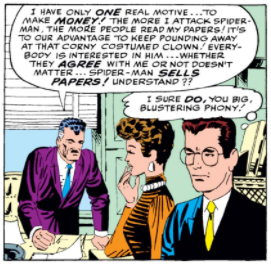 To be fair, Peter does have a right to be angry, as his life is pretty difficult. We see an example of this next as his schoolmates plan a prank to utterly humiliate him. Flash Thompson has dressed up as Spidey in order to leap out and terrify Peter, a plan which a great gang of fellow students take enormous delight in. "Poor Peter! He'll never get over it!" says one of them, full of glee.
To be fair, Peter does have a right to be angry, as his life is pretty difficult. We see an example of this next as his schoolmates plan a prank to utterly humiliate him. Flash Thompson has dressed up as Spidey in order to leap out and terrify Peter, a plan which a great gang of fellow students take enormous delight in. "Poor Peter! He'll never get over it!" says one of them, full of glee.
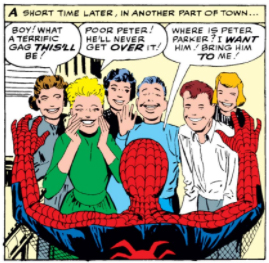 Steve Ditko really sells the relish on the faces of the students here, in much the same way that he conveys Peters rage elsewhere. This fury at an unjust world permeates the whole issue, and comes as something of a shock after the rough and tumble excitement of Kirby.
Steve Ditko really sells the relish on the faces of the students here, in much the same way that he conveys Peters rage elsewhere. This fury at an unjust world permeates the whole issue, and comes as something of a shock after the rough and tumble excitement of Kirby.
Things go wrong for Flash just as he's about to carry out his mean scheme. Doctor Doom turns up, having tracked the real Spider-Man down using a "Spider Detector" - a device which is a) somehow related to the previous bit of "Spider Telepathy" and b) also never to be used again - and kidnaps Flash by mistake. He makes this error because Flash is only a couple of feet away from Peter, who trudges by on the other side of a fence, lost in his angry thoughts.
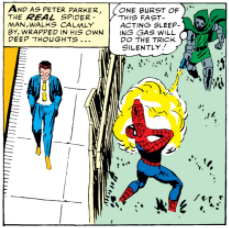 Back at Aunt May's house there's more use of television screens as narrative devices (Steve Ditko pre-empting Frank Miller's use of the same technique in 'The Dark Knight Returns' by twenty years!) as Doom reveals his cunning plan to use Spider-Man as a hostage to force the accursed Fantastic Four to give up superheroing. Say what you like about Doctor Doom but he doesn't give up on a methodology just because it's failed multiple times before. Maybe the problem with the whole "kidnap someone in order to blackmail the Fantastic Four" scheme is just that he's never tried it with Spider-Man before?
Back at Aunt May's house there's more use of television screens as narrative devices (Steve Ditko pre-empting Frank Miller's use of the same technique in 'The Dark Knight Returns' by twenty years!) as Doom reveals his cunning plan to use Spider-Man as a hostage to force the accursed Fantastic Four to give up superheroing. Say what you like about Doctor Doom but he doesn't give up on a methodology just because it's failed multiple times before. Maybe the problem with the whole "kidnap someone in order to blackmail the Fantastic Four" scheme is just that he's never tried it with Spider-Man before?
While Peter's watching all this on the news, trying to work out what on earth's going on, he gets a call from one of his classmates telling him that it's Flash who's been captured. I'm not sure why they're ringing Peter, as it's not like he can do anything about it as far as they know, and he and Flash aren't exactly chums, but it does give rise to an alarming panel where he considers doing absolutely nothing to help.
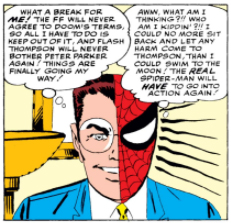 I can completely understand Peter's point of view here - Flash has made his life miserable, after all - but it's still a little disconcerting to see, especially when Ditko draws him like he's about to laucnh into a maniacal cackle, and it's yet more evidence of the way that Spider-man's personality was still in flux. He does decide to do the right thing in the end though, and sets off to track Doctor Doom down, at which point we get a remarkable caption which thanks the reader for sitting through what it describes as "the longest introduction you've ever read"! It's a lovely example of Stan Lee's supposed openness and honesty with the readers, pre-empting their complaints and folding them into the fun of Marvel. It's also true, as the action does shift up a gear at this point, with Spider-man breaking into Doom's latest headquarters and launnching into the issue's fight scene.
I can completely understand Peter's point of view here - Flash has made his life miserable, after all - but it's still a little disconcerting to see, especially when Ditko draws him like he's about to laucnh into a maniacal cackle, and it's yet more evidence of the way that Spider-man's personality was still in flux. He does decide to do the right thing in the end though, and sets off to track Doctor Doom down, at which point we get a remarkable caption which thanks the reader for sitting through what it describes as "the longest introduction you've ever read"! It's a lovely example of Stan Lee's supposed openness and honesty with the readers, pre-empting their complaints and folding them into the fun of Marvel. It's also true, as the action does shift up a gear at this point, with Spider-man breaking into Doom's latest headquarters and launnching into the issue's fight scene.
Another recurring theme in these early years of Doom and The Fantastic Four has been the nonsensical ways in which Johnny Storm's nebulous "flame powers" have been used, such as fusing water into solid forms, creating mirages, or constantly making solid devices out of fire. Something very similar happens here, with Spider-man apparently able to use his webs to create solid objects like shields and web-balls - it turns out that he got the idea from Johnny Storm!
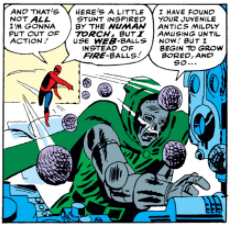 Other regular features of Doctor Doom appearances which crop up during the fight include Magnets! Electricity! and Robots! Some might say that this is Stan Lee recycling plot devices, but I like to think of it as coherent characterisation, with Doom having a standard set of fight moves he likes to use. As the battle goes on it turns out that Doom policy of re-using tactics was completely correct. These moves may have failed against the Fantastic Four, but when used against a single teenager with the powers of a spider, he actually manages to win!
Other regular features of Doctor Doom appearances which crop up during the fight include Magnets! Electricity! and Robots! Some might say that this is Stan Lee recycling plot devices, but I like to think of it as coherent characterisation, with Doom having a standard set of fight moves he likes to use. As the battle goes on it turns out that Doom policy of re-using tactics was completely correct. These moves may have failed against the Fantastic Four, but when used against a single teenager with the powers of a spider, he actually manages to win!
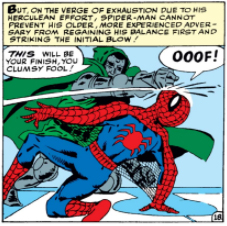 It's only the arrival of the Fantastic Four that save's Spider-Man's life, and leads to Doom repeating himself once again, by jumping out of a window to escape.
It's only the arrival of the Fantastic Four that save's Spider-Man's life, and leads to Doom repeating himself once again, by jumping out of a window to escape.
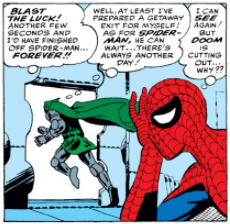 The issue ends with Spider-man having to rush home, leaving Flash Thompson to meet the Fantastic Four who, in yet another example of the joyfully casual use of the shared Marvel Universe, only actually appear in a single panel. The issue finishes with a slightly alarming scene where the adult professional Betty Brant lusts inappropriately over the certifiably under-age Peter Parker, and then a rather nice gag about Flash Thompson showing off about his part in the defeat of Doctor Doom.
The issue ends with Spider-man having to rush home, leaving Flash Thompson to meet the Fantastic Four who, in yet another example of the joyfully casual use of the shared Marvel Universe, only actually appear in a single panel. The issue finishes with a slightly alarming scene where the adult professional Betty Brant lusts inappropriately over the certifiably under-age Peter Parker, and then a rather nice gag about Flash Thompson showing off about his part in the defeat of Doctor Doom.
As well as being a thoroughly enjoyable story this issue is a great example in the way in which the shared world of Marvel comics was developing, and a clear sign that the characters were able to maintain their own personalities, and their own continuing stories, as they moved between publications. This was Doctor Doom's first trip into another series, but it would by no means be his last!
posted 21/2/2018 by MJ Hibbett
(click here for permanent link)
(0) comments
A Skrull Walks Among Us
This is yet another occasion in which Doom appears only briefly as part of the recap, this time on the first page as part of a TV broadcast which the Fantastic Four are watching. This is a lovely example of the "real world" of the Marvel Universe, with the four main characters just sitting around watching telly together. It's not something you'd expect to see in DC's comics of the time, for instance, and sets the tone for the whole first half of the issue, which features a lot of fun with a trip to Hawaii on an Intercontinental Ballistic Missile and some light shopping.
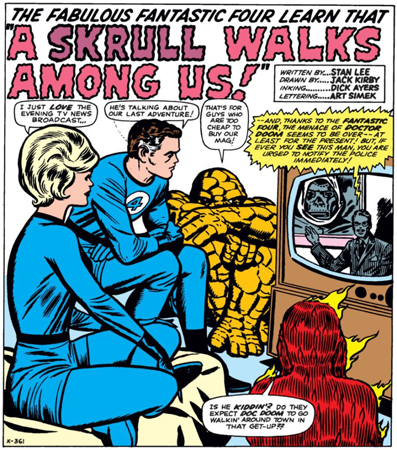 While this is going on we also visit the Skrulls, returning for the first time since their debut way back in Fantastic Four #2. On that occasion they were defeated by Reed Richard's cunning use of pictures of MONSTERS, cut out from issues of 'Strange Tales' and 'Journey Into Mystery'.
While this is going on we also visit the Skrulls, returning for the first time since their debut way back in Fantastic Four #2. On that occasion they were defeated by Reed Richard's cunning use of pictures of MONSTERS, cut out from issues of 'Strange Tales' and 'Journey Into Mystery'.
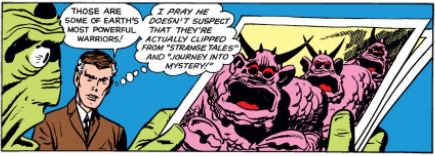 The Skrull leader has a much better plan this time. Rather than sending a bunch of dimboes who can't tell the difference between a photograph and a drawing, this time he's deploying a mighty warrior: The Super Skrull! The Super Skrull is pretty flipping cool, as we see when he lands on Earth and, much to the amazement of the New Yorkers around him, declares that he has conquered the entire planet all by himself.
The Skrull leader has a much better plan this time. Rather than sending a bunch of dimboes who can't tell the difference between a photograph and a drawing, this time he's deploying a mighty warrior: The Super Skrull! The Super Skrull is pretty flipping cool, as we see when he lands on Earth and, much to the amazement of the New Yorkers around him, declares that he has conquered the entire planet all by himself.
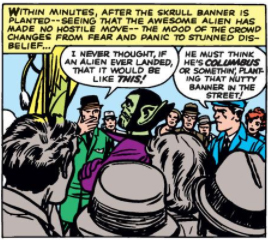 There then follows a series of fights in which the FF get thoroughly duffed up by someone who has all their powers and then some. The team retreat to the Baxter Building for the night to regroup, and it's here that Reed Richards uses his mighty brain to work out that the Super Skrull's powers are being beamed to him by a space ray! All he has to do is develop a Power Beaming Space Ray Jammer, get Sue to stick it onto the Super Skrull's neck, and voila! Problem solved!
There then follows a series of fights in which the FF get thoroughly duffed up by someone who has all their powers and then some. The team retreat to the Baxter Building for the night to regroup, and it's here that Reed Richards uses his mighty brain to work out that the Super Skrull's powers are being beamed to him by a space ray! All he has to do is develop a Power Beaming Space Ray Jammer, get Sue to stick it onto the Super Skrull's neck, and voila! Problem solved!
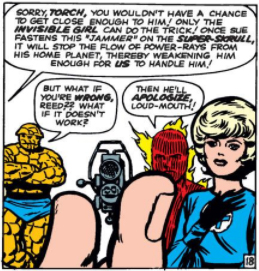 By the standards of the time this is a perfectly logical solution that is part of a lovely issue which really feels as if the series is getting into its stride. There's plenty of fun interaction between the main characters, exciting new ideas, and a finale which doesn't rely on coincidences or some new ludicrous use of Johnny's "flame power". More of this sort of thing please!
By the standards of the time this is a perfectly logical solution that is part of a lovely issue which really feels as if the series is getting into its stride. There's plenty of fun interaction between the main characters, exciting new ideas, and a finale which doesn't rely on coincidences or some new ludicrous use of Johnny's "flame power". More of this sort of thing please!
posted 16/2/2018 by MJ Hibbett
(click here for permanent link)
(0) comments
Defeated by Doctor Doom
If ever a comic undersold itself it has to be this one. The "thrills" advertised on the cover feature "America's most colorful super-combo" being menaced by such exciting dangers as concrete! scaffolding! missing floorboards! wind! It's less a superhero thrillfest, more a public information film warning children about the dangers of building sites.
Once you get inside the comic, however, it's packed full of NUTTINESS and LUNACY. It starts off fairly calmly with the Fantastic Four saying goodbye to Ant Man, last month's guest star, in a neat example of the then-new idea of linking stories together from issue to issue, and indeed from title to title, all compounded by the Thing then relaxing with a copy of "Tales To Astonish" ... featuring Ant-Man!
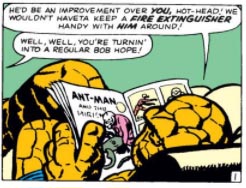 Newsstand distribution of comics at this time meant that there was no guarantee that all, or even most, of those picking up this issue would have read the previous one, so it was traditional to include a recap of previous events at the start of the current issue, usually as part of the story itself. Here Lee and Kirby create an entertaining variation by having Ben, Johnny and Sue telling the story-so-far between the three of them, featuring a lot of interplay and the group's trademark bickering. It's a nice illustration of characterisation as a key selling point for Marvel Comics, differentiating them from the interchangeable characters still being published by their competitors.
Newsstand distribution of comics at this time meant that there was no guarantee that all, or even most, of those picking up this issue would have read the previous one, so it was traditional to include a recap of previous events at the start of the current issue, usually as part of the story itself. Here Lee and Kirby create an entertaining variation by having Ben, Johnny and Sue telling the story-so-far between the three of them, featuring a lot of interplay and the group's trademark bickering. It's a nice illustration of characterisation as a key selling point for Marvel Comics, differentiating them from the interchangeable characters still being published by their competitors.
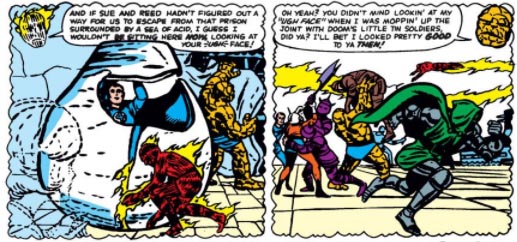 Reed however has had enough of the bickering and tells Johnny and Ben to "clam up" and stop "trading love letters". They have work to do - Doctor Doom is still at large!
Reed however has had enough of the bickering and tells Johnny and Ben to "clam up" and stop "trading love letters". They have work to do - Doctor Doom is still at large!
The team set off to inidividually search the city, which leads to a generous helping of hi-jinks. Ben falls down a manhole and then attacks a man advertising a play set in medieval times, while Sue wrecks havoc when she sees a man demonstrating a toy gun and thinks (understandably) that it's real. Neither this, nor Reed's science or Johnny's heat based sonar system (yet another example of the deranged "science" applied to the Torch's powers) get any results, so they decide to call it a day and head out to their various evening engagements.
As they're leaving they see a big crowd waiting for them in the entrance lobby, but luckily one of the janitors is able to take them out via the service elevator. Once they've gone, however, he removes his disguise and we see that it was Doctor Doom all along, working a new scheme which involves putting tracking devices on their hands!
This is where things start to get particularly nutty, as Doom releases lighter than air robots (no, shut up, that's a thing) to follow each of the four and, basically, mess up their social lives. Johnny is the first victim, as his date is upset to find them being followed around by a goonishly grinning floating zombie.
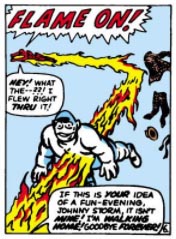 Ben is similarly embarrassed, Sue has a fashion shoot ruined by her own polka dot creature, and Reed loses his chance at an honourary degree because the stuffy old scientists think he's taking the mickey out of them with his own floating goon.
Ben is similarly embarrassed, Sue has a fashion shoot ruined by her own polka dot creature, and Reed loses his chance at an honourary degree because the stuffy old scientists think he's taking the mickey out of them with his own floating goon.
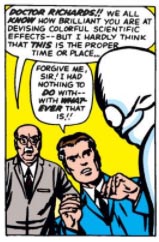 The four regroup and Reed works out that it's something to do with Dr Doom, who's watching them via cameras in the floating robots. Doom then dissolves the weird creatures and declares an end to this part of his plan.
The four regroup and Reed works out that it's something to do with Dr Doom, who's watching them via cameras in the floating robots. Doom then dissolves the weird creatures and declares an end to this part of his plan.
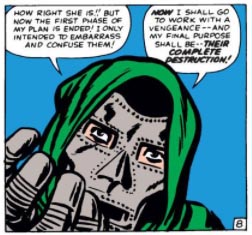 Doom says that he just wanted to wind them up, but he's surely selling himself short here, as the floating robots were an excellent way of gathering intelligence on his enemies' weaknesses. Indeed, he uses this gathered information to develop a revolutionary new scheme - instead of kidnapping Sue, he's going to kidnap Alicia instead!
Doom says that he just wanted to wind them up, but he's surely selling himself short here, as the floating robots were an excellent way of gathering intelligence on his enemies' weaknesses. Indeed, he uses this gathered information to develop a revolutionary new scheme - instead of kidnapping Sue, he's going to kidnap Alicia instead!
Doom gets a great moment of self-examination here, musing on the fact that, although he is the equal (not the better, as he would always insist in later years) of Reed Richards intellectually, his one flaw is that he doesn't understand human beings. He goes on to bemoan his status as a "dark wraith" with a deformed face, unable to ever find love and companionship.
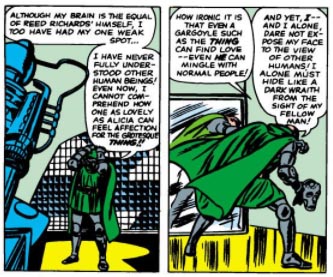 As many people, including me, have said before, the practice of giving their heroes real human motivations and their own flaws and quirks rather than just being "Good" or "Evil" is what set Marvel apart from DC and other publishers of the time. It had worked with the heroes, and here Lee and Kirby apply it to a villain too. This is shown most clearly in the image of a pained Doom unable to look at himself in the mirror, but still drawn towards it. He's still a villain doing villainous things for the sake of revenge, but you do feel some sympathy for him, rather than just waiting for the good guys to beat him up.
As many people, including me, have said before, the practice of giving their heroes real human motivations and their own flaws and quirks rather than just being "Good" or "Evil" is what set Marvel apart from DC and other publishers of the time. It had worked with the heroes, and here Lee and Kirby apply it to a villain too. This is shown most clearly in the image of a pained Doom unable to look at himself in the mirror, but still drawn towards it. He's still a villain doing villainous things for the sake of revenge, but you do feel some sympathy for him, rather than just waiting for the good guys to beat him up.
Doom carries out his brilliant new plan of kidnapping Alicia and then warns the Fantastic Four not to interfere with the next stage of his scheme, lest he unleash a series of psychedelic horrors on New York. He has a good laugh about it to himself, and then prepares the next part of his cunning scheme - to blackmail President Kennedy into making him a member of the cabinet!
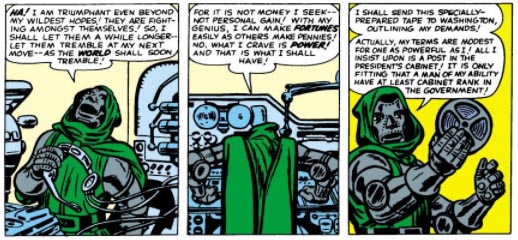 Where to start with this section? It's just three panels but it's SO full of STUFF. First of all there's Doom's laughter, echoing his gleeful enjoyment of his own plan back in issue 10. Kirby draws him in exactly the same pose, reinforcing the characterisation of Doom as someone who enjoys his work, and enjoys enjoying it!
Where to start with this section? It's just three panels but it's SO full of STUFF. First of all there's Doom's laughter, echoing his gleeful enjoyment of his own plan back in issue 10. Kirby draws him in exactly the same pose, reinforcing the characterisation of Doom as someone who enjoys his work, and enjoys enjoying it!
The rest of the sequence deals with what he sees as the nobility of his actions. He could have money if he wanted, easy peasy, but he requires something higher, more laudable - power! And he's going to do that by ... joining the advisory body of the government's executive branch. I can't be the only person who doesn't flash forward here to Austin Power's Dr Evil and his demand for "a million dollars"?
Another revolutionary aspect of "Marvel Age" storytelling was its engagement with the modern world, which we see here in a lovely sequence where John F Kennedy's hair discusses the problem posed by Doom's demands.
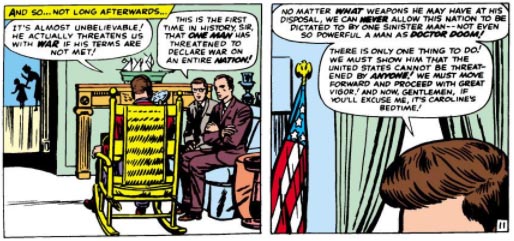 There's also an interesting look at how this affects world affairs. Doom demonstrates his power by wrecking electronic gadgets all over America, which causes much delight among Russian generals, who are then upbraided by Krushchev himself.
There's also an interesting look at how this affects world affairs. Doom demonstrates his power by wrecking electronic gadgets all over America, which causes much delight among Russian generals, who are then upbraided by Krushchev himself.
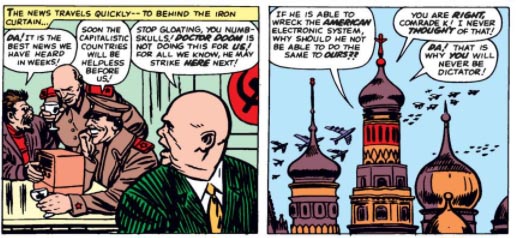 If Marvel came make their main villain into a sympathetic character then they can also make a case for the leader of America's greatest enemmies being a sensible human being. This also reflects a gradual change of attitude in the 1960s towards "the commies", as Krushchev began a gradual policy of change in the Soviet Union, leading to rapproachment in the next decade.
If Marvel came make their main villain into a sympathetic character then they can also make a case for the leader of America's greatest enemmies being a sensible human being. This also reflects a gradual change of attitude in the 1960s towards "the commies", as Krushchev began a gradual policy of change in the Soviet Union, leading to rapproachment in the next decade.
The US government come to the Fantastic Four for help, and Reed reveals that he's been busy working out what's going on. He's discovered Doom's hidden airship, and realised that the Grinning Floaters had actually been used to transmit printed circuits of the Fantastic Four's atomic and molecular structure! It wasn't just a wind-up after all!
He works all night long and develops a solution which can change him back to a human being but only temporarily. This section, by the way, is a cracking read - both men know that they have no idea how long the effect will last, which means that if he changes back too soon he'll be killed by the circuit, but they're prepared to take the risk. Thus Ben is transformed and then shot off to penetrate Doom's defenses in... er... a giant flyng sperm.
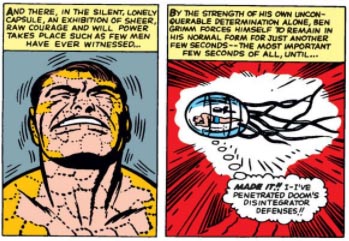 Taken out of context these two images could be telling a very different sort of story, but let us rise above that and enjoy this deliciously tense sequence, with Ben beginning to change back at precisely the wrong moment, managing to maintain his human form for just a few more seconds using sheer force of will. It's a forerunner of the classic scene from Amazing Spider-Man #33, with Peter Parker trapped beneath a giant piece of machinery and only able to extract himself through willpower. This version's a lot quicker, because there's a whole lot of other stuff going on!
Taken out of context these two images could be telling a very different sort of story, but let us rise above that and enjoy this deliciously tense sequence, with Ben beginning to change back at precisely the wrong moment, managing to maintain his human form for just a few more seconds using sheer force of will. It's a forerunner of the classic scene from Amazing Spider-Man #33, with Peter Parker trapped beneath a giant piece of machinery and only able to extract himself through willpower. This version's a lot quicker, because there's a whole lot of other stuff going on!
Ben destroys the disintegrator circuit that was preventing them all from boarding the ship, allowing his team mates to join him. It's only here, three quarters of the way through the issue, that we get to the building site perils mentioned on the cover, as the three male members of the team are disabled by specially designed traps set just for them. Doom then uses Power Spheres to transport them all into another dimension (why has he never used these before? They sound amazing!) but his victory celebrations are short lived - it turns out that he has only defeated some "flame images", not the real Fantastic Four.
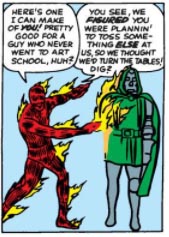 I must admit I'm getting a bit fed up with Johnny Storm's ever-expanding arsenal of ludicrous flame-based powers. How is a "flame image" a thing? It's at times like this that I want Doom to win.
I must admit I'm getting a bit fed up with Johnny Storm's ever-expanding arsenal of ludicrous flame-based powers. How is a "flame image" a thing? It's at times like this that I want Doom to win.
With the plan going awry Doom hurries off to collect his hostage, Alicia, but unfortunately Sue has beaten him to it. There's a great couple of panels here where we see Sue coming in to find Alicia distraught, then a few panels later the exact same view, with Doom creeping up on a disguised Sue. It's lovely!
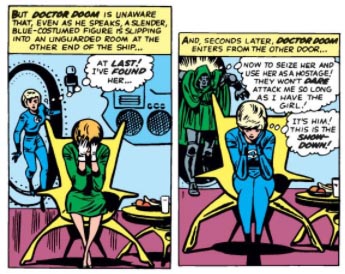 Sue then fights Doom on her own, using her powers, her brain, and judo! It's great to see her fight him to a standstill, continuing the gradual change in her character from terrified hostage-in-waiting to effective team member, although she does still need the men to turn up to save her from Doom's "ultra heat beam".
Sue then fights Doom on her own, using her powers, her brain, and judo! It's great to see her fight him to a standstill, continuing the gradual change in her character from terrified hostage-in-waiting to effective team member, although she does still need the men to turn up to save her from Doom's "ultra heat beam".
As soon as they're all together Doom realises that, once again, the jig is up, and decides that running away is by far the better part of valour. This is now a core part of Doom's character, that he will always recognise when he's beaten and decide to flee to fight again another day. If he can do this in a manner which persuades his enemies that he's actually dead, then all the better. That's exactly what happens here as, rather than be captured, he chucks himself out of the airship.
 The Fantastic Four don't have time to worry about him, as they're busy reuniting with each other, but we will later discover that's fallen a very long way indeed - into an entirely different comic altogether!
The Fantastic Four don't have time to worry about him, as they're busy reuniting with each other, but we will later discover that's fallen a very long way indeed - into an entirely different comic altogether!
posted 14/2/2018 by MJ Hibbett
(click here for permanent link)
(0) comments
The Micro World Of Doctor Doom
You get a sense of Doctor Doom's pulling power before you even open this comic, with a cover showing him towering over the Fantastic Four and a headline stating that it features "The Return Of Doctor Doom". Clearly putting "The Return Of Doctor Doom" on the cover had worked so well the last time they did it that they decided to try it again!
The story inside is called "The Micro World Of Doctor Doom", which is a distinctly less thrilling headline. It begins with Johnny Storm returning to the Baxter Building to find all three of his colleagues "reduced to the size of toys". He saves them from being killed by the Air Conditioning (not an auspicious end to a superhero career) by melting it, after which they all return to full size and, rather sheepishly, all admit that this is not the first time they've shrunken recently.
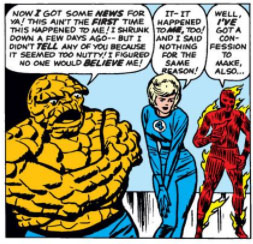 There's some delightfully non-heroic body language here, as it turns out that they were all too embarrassed to admit to having been shrunk in case the others thought they were making it up. This nervousness is despite the fact that something extremely similar happened to all of them about six months ago, when they last met Doctor Doom. The idea that this might have something to do with him doesn't seem to occur to anyone, not even to Mr Fantastic, allegedly the biggest brain on earth. I personally worked it out right away, but then I did see that he was returning on the cover so maybe that was a clue. Or maybe I'm just cleverer than Reed Richards?
There's some delightfully non-heroic body language here, as it turns out that they were all too embarrassed to admit to having been shrunk in case the others thought they were making it up. This nervousness is despite the fact that something extremely similar happened to all of them about six months ago, when they last met Doctor Doom. The idea that this might have something to do with him doesn't seem to occur to anyone, not even to Mr Fantastic, allegedly the biggest brain on earth. I personally worked it out right away, but then I did see that he was returning on the cover so maybe that was a clue. Or maybe I'm just cleverer than Reed Richards?
There follows several pages of each of them telling their own stories of shrinkage in a jolly sequence that, as Ben says, "sounds like we're playing 'Can You Top This?'".
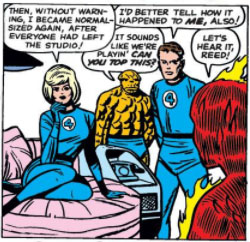 Unable to work out what is causing the shrinking they decide to call in Ant Man, recent star of "Tales To Astonish". This is an early example of Stan Lee knitting together the Marvel Universe as a cohesive fictional storyworld. Whereas other superhero series, existing in their own isolated worlds, would have had to invent a Professor Of Shrinking to explain what's going on, the Fantastic Four are able to call on a pre-existing Shrinking Expert from another comic who happens to live in the same city. This little piece of cross-title interaction happens so casually and quickly that it's easy to forget how revolutionary it was at the time.
Unable to work out what is causing the shrinking they decide to call in Ant Man, recent star of "Tales To Astonish". This is an early example of Stan Lee knitting together the Marvel Universe as a cohesive fictional storyworld. Whereas other superhero series, existing in their own isolated worlds, would have had to invent a Professor Of Shrinking to explain what's going on, the Fantastic Four are able to call on a pre-existing Shrinking Expert from another comic who happens to live in the same city. This little piece of cross-title interaction happens so casually and quickly that it's easy to forget how revolutionary it was at the time.
Ant Man flies over on a couple of flying ants and lends the team his amazing shrinking/growing potion, which requires one drop to make you smaller, and another to make you tall. This has a very Alice In Wonderland kind of vibe (several years before Jefferson Airplane had a hit with "White Rabbit") but I think that, in this case, it may not be an intentional reference, if only because when it is intended a character will usually draw attention to it!
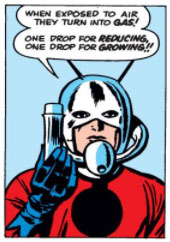 Even though the Fantastic Four have a lot on their plate at the moment, what with the unfathomable attacks from a mysterious unknown nemesis who hates them and uses shrinking rays, Reed Richards still has time to pursue other projects. The next day he pops round to give Ben another potion which, temporarily, turns him back into his human form. Unfortunately for Alicia, Ben was holding up her piano with one hand at the time, so drops it as soon as he's no longer the Thing. know science is exciting, but surely even in the 1960s they had some sort of health and safety awareness to stop this sort of accident happening?
Even though the Fantastic Four have a lot on their plate at the moment, what with the unfathomable attacks from a mysterious unknown nemesis who hates them and uses shrinking rays, Reed Richards still has time to pursue other projects. The next day he pops round to give Ben another potion which, temporarily, turns him back into his human form. Unfortunately for Alicia, Ben was holding up her piano with one hand at the time, so drops it as soon as he's no longer the Thing. know science is exciting, but surely even in the 1960s they had some sort of health and safety awareness to stop this sort of accident happening?
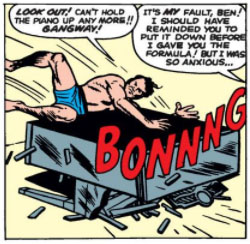 Sue and Johnny are also going about their everyday business - Johnny showing off to school friends, Sue testing out perfumes to see if they disguise her from dogs (that's her story anyway, I think she just wanted an excuse to fill the lab with adorable dogs).
Sue and Johnny are also going about their everyday business - Johnny showing off to school friends, Sue testing out perfumes to see if they disguise her from dogs (that's her story anyway, I think she just wanted an excuse to fill the lab with adorable dogs).
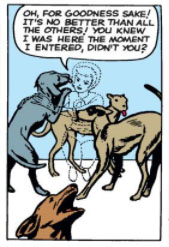 Suddenly they all hear a voice telling them to beware of Doctor Doom, which finally - FINALLY - leads them to suspect that he might still be alive (like he has been every other time they thought he was dead) and behind their recent attacks. They immediately take the shrinking potion and shrink down into another universe - the Micro-World of Doctor Doom!
Suddenly they all hear a voice telling them to beware of Doctor Doom, which finally - FINALLY - leads them to suspect that he might still be alive (like he has been every other time they thought he was dead) and behind their recent attacks. They immediately take the shrinking potion and shrink down into another universe - the Micro-World of Doctor Doom!
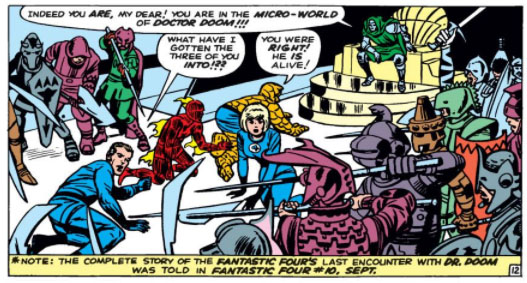 It's taken over half of the issue for the cover star to make an appearance - who said decompressed storytelling was something new? Doom is very Doom-like right from the off, relaxing in a throne, using local people to do his work for him, and eager to fill his enemies in on what he's been up to since they last saw them. He too shrank down to this other universe and found a people living a peaceful, happy life, which of course made him FURIOUS!
It's taken over half of the issue for the cover star to make an appearance - who said decompressed storytelling was something new? Doom is very Doom-like right from the off, relaxing in a throne, using local people to do his work for him, and eager to fill his enemies in on what he's been up to since they last saw them. He too shrank down to this other universe and found a people living a peaceful, happy life, which of course made him FURIOUS!
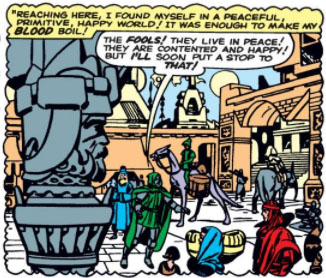 We're still over a year away from learning Doom's full origin, but his adventures in the Micro World are very similar to what we will learn of his history in Latveria. Here, as there, he uses his scientific skills to fool an easily impressed aristocracy. Gradually he takes over a quasi-medieval society, gaining the trust of the locals to help him build his devices, and then takes power for himself. "Conning the masses" is pretty much Doom's main superpower, and he must be really good at it. If someone in a grey metal skull mask calling himself "Doctor Doom" turned up and said he was here to help, you'd think people would see through him. But then again, in the world of Trump, who are we to judge the innocent denizens of the Micro World?
We're still over a year away from learning Doom's full origin, but his adventures in the Micro World are very similar to what we will learn of his history in Latveria. Here, as there, he uses his scientific skills to fool an easily impressed aristocracy. Gradually he takes over a quasi-medieval society, gaining the trust of the locals to help him build his devices, and then takes power for himself. "Conning the masses" is pretty much Doom's main superpower, and he must be really good at it. If someone in a grey metal skull mask calling himself "Doctor Doom" turned up and said he was here to help, you'd think people would see through him. But then again, in the world of Trump, who are we to judge the innocent denizens of the Micro World?
After the usual capture of Sue, followed by everybody being dosed with sleeping gas, the Fantastic Four find themselves imprisoned in a cell inside a lake of acid, along with the King of the Micro World and his daughter, Princess Pearla. Pearla explains that Doom has summoned the Lizard Men of Tok to come and discuss an alliance, and they're arriving any minute!
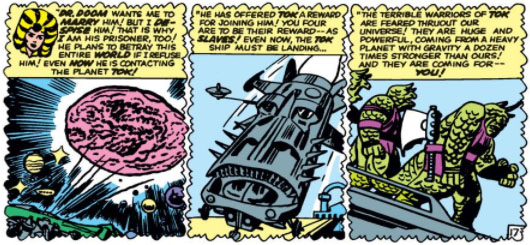 I love the Lizard Men of Tok, mostly because of their name, but also because of their brilliantly weird-looking spaceship. Pearla then describes, with slightly more gusto than perhaps necessary, the iniquities that will befall her fellow prisoners, with Reed being used as a bridge, Ben as a miner, Johnny as a flame thrower and Sue as... a scullery maid? I'm sure being invisible would be handy for spying, but the Lizard Men Of Tok clearly require a cook more than they do tactical intelligence. Still, is it me or is this a great look for Sue? Not the drudgery, but the hairdo:
I love the Lizard Men of Tok, mostly because of their name, but also because of their brilliantly weird-looking spaceship. Pearla then describes, with slightly more gusto than perhaps necessary, the iniquities that will befall her fellow prisoners, with Reed being used as a bridge, Ben as a miner, Johnny as a flame thrower and Sue as... a scullery maid? I'm sure being invisible would be handy for spying, but the Lizard Men Of Tok clearly require a cook more than they do tactical intelligence. Still, is it me or is this a great look for Sue? Not the drudgery, but the hairdo:
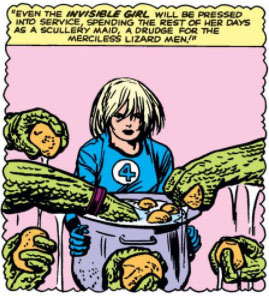 Maybe it's the fed-up expression, but I reckon she looks like a supermodel.
Maybe it's the fed-up expression, but I reckon she looks like a supermodel.
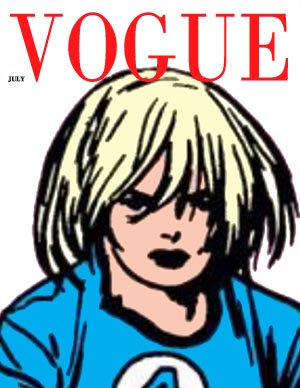 In a nice change from Sue's usual passiveness, this time she's the one who has the brilliant idea of tearing down parts of the acid-proof wall cladding to make an escape pod, and it's Sue who then rescues Ant Man, who came to help but got himself instantly captured by Doom's men.
In a nice change from Sue's usual passiveness, this time she's the one who has the brilliant idea of tearing down parts of the acid-proof wall cladding to make an escape pod, and it's Sue who then rescues Ant Man, who came to help but got himself instantly captured by Doom's men.
The rest of the Fantastic Four race to head off the incoming Lizard Men of Tok, which The Thing does rather elegantly by picking up a control tower and using it as a baseball bat to whack them back into space.
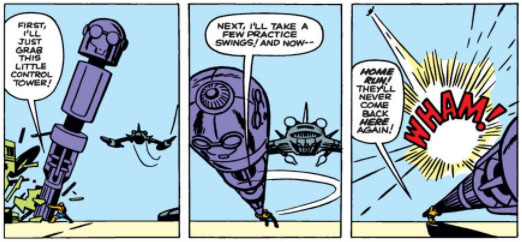 It's a great visual, but I must admit to being a bit sad that we never got to meet them. Come back soon, Lizard Men of Tok!
It's a great visual, but I must admit to being a bit sad that we never got to meet them. Come back soon, Lizard Men of Tok!
Back in the throne room it all kicks off, with Sue stealing Doom's gun and Ant Man duffing up the army. Doom knows the jig is up, so runs away, using his own shrinking/growing device to boost himself up to our universe once again. All that's left is for Johnny to say goodbye to Pearla, who wanted him to stay, and then to head off to the next issue, where Doom will be waiting!
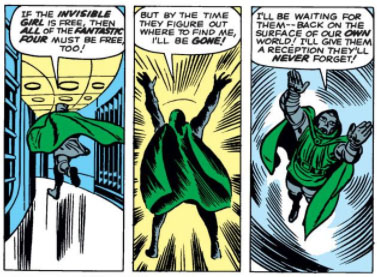
posted 7/2/2018 by MJ Hibbett
(click here for permanent link)
(2) comments
The Patriarchal Four
This is another brief Doom cameo, with him appearing only once in Fantastic Four #14 on The Puppet Master's mental list of all the Fantastic Four's enemies.
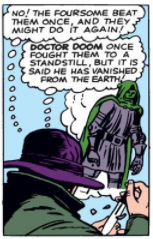 The rest of the story is not what anyone would call a classic, not least because of the eye-watering sexism that goes on throughout. It begins with the team returning to base, knackered from their previous adventure. Once they get in the men sit down to relax while Sue goes off to do some cleaning. "That's fine, as long as you do it in silence", says Reed.
The rest of the story is not what anyone would call a classic, not least because of the eye-watering sexism that goes on throughout. It begins with the team returning to base, knackered from their previous adventure. Once they get in the men sit down to relax while Sue goes off to do some cleaning. "That's fine, as long as you do it in silence", says Reed.
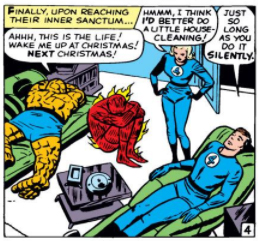 That's nice isn't it? Reed continues to be a complete git throughout the story. For instance, shortly after this incident he writes up some of his scientific thoughts and then hands his notes over to Sue to type up for him, because clearly this is woman's work.
That's nice isn't it? Reed continues to be a complete git throughout the story. For instance, shortly after this incident he writes up some of his scientific thoughts and then hands his notes over to Sue to type up for him, because clearly this is woman's work.
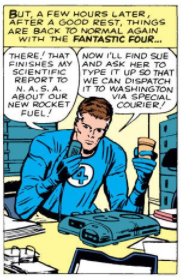 Reed isn't the only misogynist in this story, with Ben later complimenting Alicia on being the only woman he knows who is able to keep quiet.
Reed isn't the only misogynist in this story, with Ben later complimenting Alicia on being the only woman he knows who is able to keep quiet.
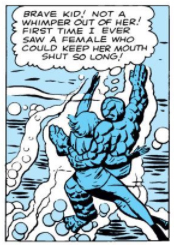 This is all while they're on a mission to save Sue, who has been taken hostage yet again as a consequence of her darned female weakness for the near naked body of the Submariner. It is, to be honest, a bit alarming. I know this was all published over fifty years ago, but the extent of the misogyny throughout the issue is still quite surprising.
This is all while they're on a mission to save Sue, who has been taken hostage yet again as a consequence of her darned female weakness for the near naked body of the Submariner. It is, to be honest, a bit alarming. I know this was all published over fifty years ago, but the extent of the misogyny throughout the issue is still quite surprising.
The plotting is completely all over the place too, though at least there's some humour about it. For instance, when The Thing sees Sue guarded by a Giant Octopus he remarks that he wouldn't have believed it if he'd read it in a magazine - a technique that I believe the critics call "lampshading", where attention is intentionally drawn to an implausible plot point, in the highlighting it will excuse it.
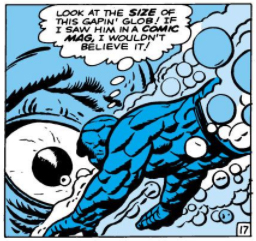 Another example is the Puppet Master's cunning scheme, which is to use mind control to force the Submariner to destroy the Fantastic Four for him. The reader would surely be thinking "Why doesn't he just mind control them and get them to kill themselves?" and the Puppet Master answers this question halfway through, almost as if Stan Lee suddenly realised that there was a gaping hole in his plot.
Another example is the Puppet Master's cunning scheme, which is to use mind control to force the Submariner to destroy the Fantastic Four for him. The reader would surely be thinking "Why doesn't he just mind control them and get them to kill themselves?" and the Puppet Master answers this question halfway through, almost as if Stan Lee suddenly realised that there was a gaping hole in his plot.
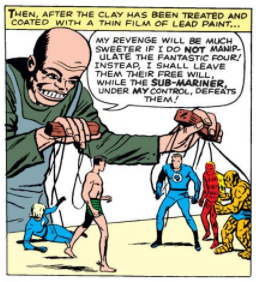 There's also a lovely scene where The Thing goes to park the Fantasticar and gets stung by a parking attendant who doubles the ticket price because he can see he's in a hurry. It's a great example of Lee and Kirby's innovation in setting fantastical events in very real world settings.
There's also a lovely scene where The Thing goes to park the Fantasticar and gets stung by a parking attendant who doubles the ticket price because he can see he's in a hurry. It's a great example of Lee and Kirby's innovation in setting fantastical events in very real world settings.
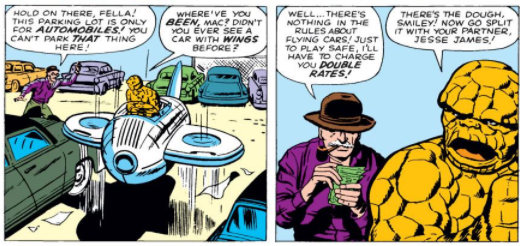 Unfortunately none of this humour makes you forget quite how unpleasant some of the gender politics is in this story, so let's hope there's less of it when we regroup for the next blog which features the second (but definitely not last) Return Of Doctor Doom!
Unfortunately none of this humour makes you forget quite how unpleasant some of the gender politics is in this story, so let's hope there's less of it when we regroup for the next blog which features the second (but definitely not last) Return Of Doctor Doom!
posted 5/2/2018 by MJ Hibbett
(click here for permanent link)
(0) comments
Johnny Storm The Human Idiot
When I set out on this pulse-pounding project I combined several different comics databases in order to select a "corpus" of comics which, in theory, featured Doctor Doom. I say "in theory" because the different ways these databases list character appearances, and the different people who do it, means that several comics got into my list where Doctor Doom doesn't actually appear in the story itself.
An excellent example of this is The Incredible Hulk #2 which doesn't feature Doctor Doom at all, except for an advert promoting Fantastic Four #5. Interestingly (for a certain value of "interesting"), in this advert his mask is coloured correctly, rather than the green version that appeared on the actual cover.
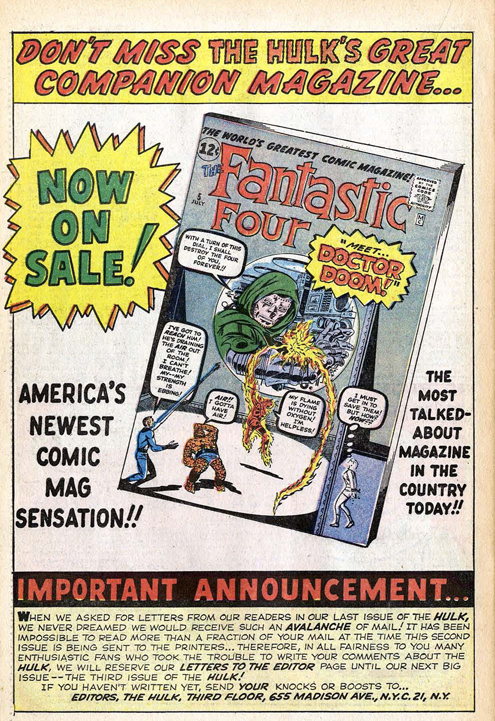 There are other occasions when he does appear in the story but only in passing, such as when another character mentions him, or he pops up in a flashback. As discussed previously I'm going to keep these stories in the final corpus because they count towards Doom's presence in the Marvel Universe as a whole, but I'm not intending to devote any of the main weekly blogs to them as there won't be much to say, Doom-wise.
There are other occasions when he does appear in the story but only in passing, such as when another character mentions him, or he pops up in a flashback. As discussed previously I'm going to keep these stories in the final corpus because they count towards Doom's presence in the Marvel Universe as a whole, but I'm not intending to devote any of the main weekly blogs to them as there won't be much to say, Doom-wise.
"Doom-wise" is a great phrase which I hope to be using constantly during the lifetime of this blog, by the way.
I do however plan to talk about them a bit, starting with the very first Doom cameo in a rather wonderful story called "The Threat Of The Torrid Twosome" in Strange Tales #106.
This one appears in the databases because Doctor Doom appears briefly in a single panel (making Dick Ayers the first person apart from Kirby to draw Doom), as the Human Torch thinks back on some of the times when he, the Torch, has been completely brilliant, and definitely the best member of the Fantastic Four.
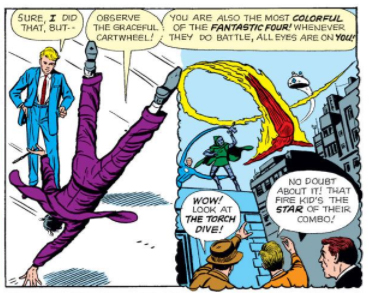 This sets out the theme for the entire story: Johnny Storm is a total idiot. Having said that, his daftness is portrayed in a surprisingly endearing way, like an adult looking back on what it was really like to be a teenager. Teenagers in comic books, in all media in fact, are often shown as wise, pure, questioning and unfettered by the petty concerns of dreary adult life, which is a lovely thing to think if you actually are a teenager, but of course completely unrealistic. I am sure there are teenagers who aren't self-obsessed idiots, but I have certainly never met any, even (especially) when I was one myself. When I think back to the decisions I made at that age my overriding thought is always "Why on earth did I do that?" and the answer is always "Because I was an idiot."
This sets out the theme for the entire story: Johnny Storm is a total idiot. Having said that, his daftness is portrayed in a surprisingly endearing way, like an adult looking back on what it was really like to be a teenager. Teenagers in comic books, in all media in fact, are often shown as wise, pure, questioning and unfettered by the petty concerns of dreary adult life, which is a lovely thing to think if you actually are a teenager, but of course completely unrealistic. I am sure there are teenagers who aren't self-obsessed idiots, but I have certainly never met any, even (especially) when I was one myself. When I think back to the decisions I made at that age my overriding thought is always "Why on earth did I do that?" and the answer is always "Because I was an idiot."
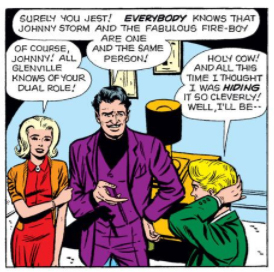 Great idiotic acts in this issue include working hard to protect a non-existent secret identity (he thinks that nobody will associate him, Johnny Storm, with the world famous Johnny Storm who looks exactly like him and also has a sister called Sue) and joining a brand new team called "The Torrid Twosome". Clearly Johnny doesn't know what the word "Torrid" means, but can't be bothered to get a dictionary because he is, as stated above, an idiot.
Great idiotic acts in this issue include working hard to protect a non-existent secret identity (he thinks that nobody will associate him, Johnny Storm, with the world famous Johnny Storm who looks exactly like him and also has a sister called Sue) and joining a brand new team called "The Torrid Twosome". Clearly Johnny doesn't know what the word "Torrid" means, but can't be bothered to get a dictionary because he is, as stated above, an idiot.
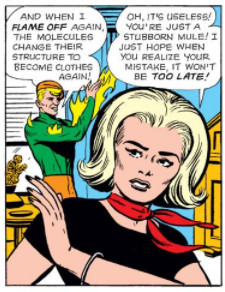 Beautifully, Stan Lee highlights this idiocy throughout, with other characters referring to it constantly. Local children laugh at Johnny behind his back because of his supposed secret identity, Sue Storm gives up trying to persuade him out of his stupid plans for The Torrid Twosome and tells him to just get on with it, and The Acrobat, the story's supposed villain, laughs constantly at what a pillock Johnny is and how easy it's been to trick him into opening a bank vault for him. Eventually the day is saved by The Fantastic Four who, like my mum secretly following me on my paper round to make sure I'm all right, have followed at a safe distance to check that he's okay.
Beautifully, Stan Lee highlights this idiocy throughout, with other characters referring to it constantly. Local children laugh at Johnny behind his back because of his supposed secret identity, Sue Storm gives up trying to persuade him out of his stupid plans for The Torrid Twosome and tells him to just get on with it, and The Acrobat, the story's supposed villain, laughs constantly at what a pillock Johnny is and how easy it's been to trick him into opening a bank vault for him. Eventually the day is saved by The Fantastic Four who, like my mum secretly following me on my paper round to make sure I'm all right, have followed at a safe distance to check that he's okay.
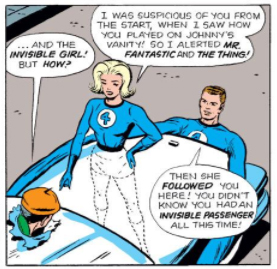 The main difference between me and Johnny is that I didn't get shot by a Frenchman while delivering The Peterborough Advertiser, which demonstrates once and for all that my mum is better than 75% of The Fantastic Four. The issue concludes with Johnny trying to make out that he new The Acrobat was a wrong'un all along, and he was carrying out a cunning plan to catch him. The rest of the Fantastic Four are all very nice about it, but it's absolutely clear that they don't believe a word he's saying.
The main difference between me and Johnny is that I didn't get shot by a Frenchman while delivering The Peterborough Advertiser, which demonstrates once and for all that my mum is better than 75% of The Fantastic Four. The issue concludes with Johnny trying to make out that he new The Acrobat was a wrong'un all along, and he was carrying out a cunning plan to catch him. The rest of the Fantastic Four are all very nice about it, but it's absolutely clear that they don't believe a word he's saying.
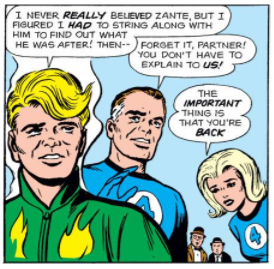 It's a not a particularly thrilling superhero story, but it is a surprisingly touching depiction of a teenager from someone who's long stopped being one, and well worth a read.
It's a not a particularly thrilling superhero story, but it is a surprisingly touching depiction of a teenager from someone who's long stopped being one, and well worth a read.
The next comic we'll be looking at is another cameo, this time in a story which defies logic and, indeed, good manners. It'll be up on the blog on Monday, but in the meantime any thoughts on this, or any other issues so far, would be most appreciated in the comments!
posted 2/2/2018 by MJ Hibbett
(click here for permanent link)
(0) comments